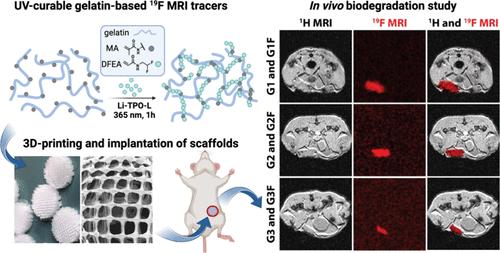当前位置:
X-MOL 学术
›
Chem. Mater.
›
论文详情
Our official English website, www.x-mol.net, welcomes your feedback! (Note: you will need to create a separate account there.)
19F MRI In Vivo Monitoring of Gelatin-Based Hydrogels: 3D Scaffolds with Tunable Biodegradation toward Regenerative Medicine
Chemistry of Materials ( IF 8.6 ) Pub Date : 2024-04-19 , DOI: 10.1021/acs.chemmater.3c03321 Kristyna Kolouchova 1 , Vit Herynek 2 , Ondrej Groborz 3, 4 , Jiří Karela 2 , Lana Van Damme 1 , Jan Kucka 5 , Adam Šafanda 6 , Quang Hiep Bui 6 , Ludek Sefc 2 , Sandra Van Vlierberghe 1
Chemistry of Materials ( IF 8.6 ) Pub Date : 2024-04-19 , DOI: 10.1021/acs.chemmater.3c03321 Kristyna Kolouchova 1 , Vit Herynek 2 , Ondrej Groborz 3, 4 , Jiří Karela 2 , Lana Van Damme 1 , Jan Kucka 5 , Adam Šafanda 6 , Quang Hiep Bui 6 , Ludek Sefc 2 , Sandra Van Vlierberghe 1
Affiliation

|
Gelatin-based hydrogels emerged as promising biodegradable cell-compatible 3D-printable materials with tunable mechanical properties that serve tissue engineering and applications in regenerative medicine. Nevertheless, these materials are very challenging to monitor in vivo, which has hampered the further development of these materials and their translation into clinical practice. To overcome this limitation, we designed a cross-linked 3D-printable gelatin-based hydrogel endowed with poly[N-(2,2-difluoroethyl)acrylamide] (PDFEA). Such PDFEA-containing hydrogels can be monitored in vivo through fluorine-19 magnetic resonance imaging (19F MRI), which enables to monitor such implants in vivo and to assess their in vivo biodegradation kinetics. Herein, we prepared three different PDFEA-containing hydrogels with varying cross-linking degrees and studied their physicochemical properties (storage modulus, Young’s modulus, swelling ratio, in vitro degradation rate). Next, we administered these samples subcutaneously into mice and exploited 19F MRI to detect the biodegradation kinetics over 370 days. Hydrogels with a high cross-linking degree did not extensively degrade in vitro nor in vivo within the evaluated time frame. In contrast, hydrogels characterized by a low degree of cross-linking extensively degraded in vitro as well as in vivo (half-life of 228 ± 21 days). We demonstrated that endowing hydrogels with PDFEA enables monitoring of these hydrogels in vivo. Our results may become a benchmark in forthcoming studies of biodegradable hydrogels and the development of 19F MRI detectable gelatin-based hydrogels, paving the way toward their entry in clinical practice.
中文翻译:

明胶基水凝胶的 19F MRI 体内监测:具有可调节生物降解能力的 3D 支架,用于再生医学
基于明胶的水凝胶是一种有前途的可生物降解的细胞兼容的 3D 打印材料,具有可调的机械性能,可用于组织工程和再生医学的应用。然而,这些材料的体内监测非常具有挑战性,这阻碍了这些材料的进一步开发及其转化为临床实践。为了克服这一限制,我们设计了一种具有聚[ N- (2,2-二氟乙基)丙烯酰胺](PDFEA)的交联可3D打印明胶基水凝胶。这种含有 PDFEA 的水凝胶可以通过氟 19 磁共振成像(19 F MRI)进行体内监测,从而能够在体内监测此类植入物并评估其体内生物降解动力学。在此,我们制备了三种不同交联度的含PDFEA水凝胶,并研究了它们的理化性质(储能模量、杨氏模量、溶胀比、体外降解率)。接下来,我们将这些样品皮下注射到小鼠体内,并利用19 F MRI 检测 370 天内的生物降解动力学。在评估的时间范围内,具有高交联度的水凝胶在体外和体内都没有广泛降解。相比之下,以低交联度为特征的水凝胶在体外和体内都会广泛降解(半衰期为 228 ± 21 天)。我们证明,赋予水凝胶 PDFEA 可以在体内监测这些水凝胶。我们的结果可能成为即将进行的可生物降解水凝胶研究和19 F MRI 可检测明胶基水凝胶开发的基准,为其进入临床实践铺平道路。
更新日期:2024-04-24
中文翻译:

明胶基水凝胶的 19F MRI 体内监测:具有可调节生物降解能力的 3D 支架,用于再生医学
基于明胶的水凝胶是一种有前途的可生物降解的细胞兼容的 3D 打印材料,具有可调的机械性能,可用于组织工程和再生医学的应用。然而,这些材料的体内监测非常具有挑战性,这阻碍了这些材料的进一步开发及其转化为临床实践。为了克服这一限制,我们设计了一种具有聚[ N- (2,2-二氟乙基)丙烯酰胺](PDFEA)的交联可3D打印明胶基水凝胶。这种含有 PDFEA 的水凝胶可以通过氟 19 磁共振成像(19 F MRI)进行体内监测,从而能够在体内监测此类植入物并评估其体内生物降解动力学。在此,我们制备了三种不同交联度的含PDFEA水凝胶,并研究了它们的理化性质(储能模量、杨氏模量、溶胀比、体外降解率)。接下来,我们将这些样品皮下注射到小鼠体内,并利用19 F MRI 检测 370 天内的生物降解动力学。在评估的时间范围内,具有高交联度的水凝胶在体外和体内都没有广泛降解。相比之下,以低交联度为特征的水凝胶在体外和体内都会广泛降解(半衰期为 228 ± 21 天)。我们证明,赋予水凝胶 PDFEA 可以在体内监测这些水凝胶。我们的结果可能成为即将进行的可生物降解水凝胶研究和19 F MRI 可检测明胶基水凝胶开发的基准,为其进入临床实践铺平道路。



























 京公网安备 11010802027423号
京公网安备 11010802027423号